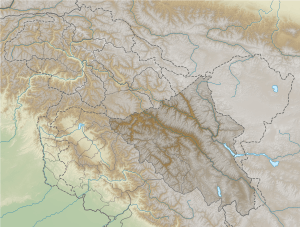Rimo I
Rimo I is the main summit of the Rimo massif with an elevation of 7,385 metres (24,229 ft). It lies in the northern part of the remote Rimo Muztagh, a subrange of the Karakoram range. It is located about 20 km northeast of the snout of the Siachen Glacier and is the world's 71st highest mountain. Rimo means "striped mountain".[3] The Rimo Glacier, originating here, drains to the Shyok river.
| Rimo I | |
|---|---|
 Rimo I Location in Ladakh | |
| Highest point | |
| Elevation | 7,385 m (24,229 ft) [1] Ranked 71st |
| Prominence | 1,438 m (4,718 ft) [1] |
| Coordinates | 35°21′21″N 77°22′05″E |
| Geography | |
| Location | Siachen area of Ladakh, controlled by India, claimed by Pakistan[2] |
| Parent range | Rimo Muztagh, Karakoram |
| Climbing | |
| First ascent | July 28, 1988 by Nima Dorje Sherpa, Tsewang Samanla (India); Yoshio Ogata, Hideki Yoshida (Japan) |
| Easiest route | South Face/Southwest Ridge |
Due to its remote location in the heart of the eastern Karakoram, Rimo was little-known and almost entirely unvisited until the twentieth century. Explorers Filippo De Filippi and Philip and Jenny Visser visited the area in 1914 and 1929 respectively. Adding to its isolation is the unsettled political and military situation between India and Pakistan in the region, especially on the nearby Siachen Glacier. This means that India controls access to the massif.
Rimo massif
The Rimo massif consists of six peaks sharing the Rimo name. In addition to Rimo I, they are:
| Peak name | Elevation m (ft) | Prominence m (ft) | Coordinates |
|---|---|---|---|
| Rimo II[4] | 7,373 m (24,190 ft) | 73 m (240 ft) | 35°21′N 77°22′E |
| Rimo III[5] | 7,233 m (23,730 ft) | 615 m (2,018 ft) | 35°22′31″N 77°21′42″E |
| Rimo IV[6] | 7,169 m (23,520 ft) | 329 m (1,079 ft) | 35°23′N 77°23′E |
| Rimo V[7] | 6,882 m (22,579 ft) | 262 m (860 ft) | 35°24′N 77°23′E |
| Rimo VI[8] | 6,846 m (22,461 ft) | 446 m (1,463 ft) | 35°25′N 77°23′E |
Rimo II is a minor subpeak located about 150 m (490 ft) northeast of Rimo I, on its north ridge. The others are more independent peaks further north. Rimo III is the 98th highest mountain in the world (Rimo II is unranked, lacking sufficient prominence).
The massif heads the large Central Rimo Glacier (on the north side) and South Rimo Glacier (on the east side), as well as the smaller North Terong Glacier (on the west side).
Climbing history
The first attempts on the Rimo massif were in 1978, by a Japanese expedition which had little success, in 1984 (first ascent of Rimo IV, by an Indian army expedition) and in 1985, by a well-organized Indian/British expedition led by famed Himalayan expert Harish Kapadia. That expedition climbed Rimo III (Dave Wilkinson and Jim Fotheringham were the summit party) but did not succeed on Rimo I.
The first, and so far only, ascent of Rimo I was made in 1988 by an Indian/Japanese team led by Hukam Singh and Yoshio Ogata. They climbed the south face to the southwest ridge, starting from a significant pass called Ibex Col on the south side of the mountain. The ascent involved 1500m of significant technical climbing.
See also
- List of highest mountains
- Harish Kapadia
References
- "Rimo I, India". Peakbagger.com. Retrieved 2015-02-16.
- India is in de facto control of this region of Kashmir; the region is claimed by Pakistan. See e.g. The Future of Kashmir on the BBC website.
- "Asia, India–Karakoram, Nomenclature in the Terrong Valley". American Alpine Journal. 28 (60): 266. 1986. Retrieved 2015-02-15.
- "Rimo II, India". Peakbagger.com. Retrieved 2015-02-17.
- "Rimo III, India". Peakbagger.com. Retrieved 2015-02-17.
- "Rimo IV, India". Peakbagger.com. Retrieved 2015-02-17.
- "Rimo V, India". Peakbagger.com. Retrieved 2015-02-17.
- "Rimo VI, India". Peakbagger.com. Retrieved 2015-02-17.
- Sources
- Jerzy Wala, Orographical Sketch Map of the Karakoram, Swiss Foundation for Alpine Research, Zurich, 1990.
- Fanshawe, Andy; Venables, Stephen (1995). Himalaya Alpine-Style. Hodder and Stoughton.